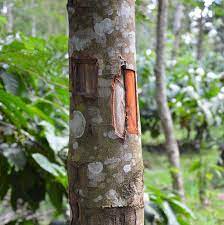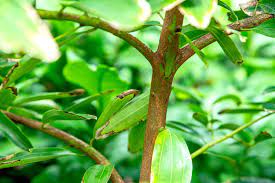Cinnamon phloem refers to the phloem tissue found in cinnamon plants, specifically the phloem that carries nutrients and sugars throughout the cinnamon tree (Cinnamomum spp.). The phloem is one of the vascular tissues in plants responsible for transporting sugars, organic nutrients, and other important substances from the leaves (where they are produced through photosynthesis) to other parts of the plant.
The phloem in cinnamon plants, like in other plants, is composed of several cell types, including sieve tubes, companion cells, phloem parenchyma, and phloem fibers. These cells work together to facilitate the efficient transport of nutrients and sugars.
Sieve Tubes: Sieve tubes are the main conducting cells of the phloem. They form long, tubular structures that are responsible for transporting sugars and other organic materials. These tubes are lined with sieve plates that allow for the movement of substances between adjacent sieve tubes Companion cells are closely associated with sieve tubes and play a crucial role in supporting the function of sieve tubes. They assist in maintaining the metabolic activities and overall function of the phloem.
Phloem parenchyma consists of living cells that store nutrients and provide support to the phloem tissue. They also contribute to the transportation of sugars and other substances. Phloem fibers provide structural support to the phloem tissue. These long, elongated cells help maintain the overall integrity and strength of the phloem.
The phloem in cinnamon plants transports sugars, amino acids, hormones, and other essential nutrients synthesized in the leaves during photosynthesis to various parts of the plant. In the case of cinnamon, sugars and other compounds are transported from the leaves to different parts of the tree, including the bark, where cinnamon is harvested.
The Economic Importance and Uses of Cinnamon Phloem

Cinnamon is a spice obtained from the bark of several trees from the Cinnamomum genus, particularly Cinnamomum verum (true cinnamon) and Cinnamomum cassia (cassia cinnamon). The phloem of cinnamon trees contains essential oils and other compounds that give cinnamon its characteristic flavor and aroma. The economic importance and uses of cinnamon phloem are significant and varied:
1. Spice Production: The primary economic use of cinnamon phloem is for spice production. Cinnamon is a popular spice used globally in cooking, baking, and beverages. Its distinct and aromatic flavor adds richness to various dishes, making it a valuable ingredient in both culinary and food processing industries.
2. Aromatic and Flavoring Agent: The essential oils found in the phloem are responsible for the distinct aroma and flavor of cinnamon. These oils, such as cinnamaldehyde, eugenol, and linalool, make cinnamon a highly sought-after ingredient in the food, beverage, and confectionery industries.
3. Medicinal and Therapeutic Uses: Cinnamon has been used in traditional medicine for centuries due to its potential health benefits. It is believed to have anti-inflammatory, antifungal, antibacterial, and antioxidant properties. The phloem’s compounds are utilized in traditional and modern medicine for treating various ailments, improving digestion, managing blood sugar levels, and promoting overall well-being.
4. Pharmaceutical Applications: The compounds extracted from cinnamon phloem find applications in the pharmaceutical industry for producing medications and supplements. Cinnamaldehyde, for instance, is used in mouthwashes, toothpaste, and pharmaceutical formulations.
5. Aromatherapy and Perfumery: The aromatic properties of cinnamon make it a valuable component in aromatherapy and perfumery. The essential oils derived from cinnamon phloem are used in making perfumes, scented candles, and other fragranced products.
6. Flavoring in Beverages: Cinnamon is used to flavor a variety of beverages, including teas, coffees, mulled wines, and liqueurs. The phloem’s essential oils impart a pleasant taste and aroma to these beverages.
7. Culinary Applications: Cinnamon is used in both sweet and savory dishes. It is a key ingredient in many desserts, such as cakes, pies, cookies, and puddings, enhancing their taste and aroma. It’s also used in curries, stews, and sauces to add a unique flavor.
8. Food Preservation: The antimicrobial properties of cinnamon’s essential oils make it useful for food preservation, extending the shelf life of certain food products.
9. Cosmetic and Personal Care Products: Cinnamon phloem compounds are used in the production of cosmetics, including skincare and haircare products, due to their aromatic properties and potential skin benefits.
Read Also: Cinnamon Bark: Economic Importance, Uses, and By-Products
10. Flavoring Tobacco and Chewing Gum: Cinnamon flavor is often used in the tobacco industry to enhance the taste of cigarettes and other tobacco products. Additionally, cinnamon-flavored chewing gum is popular, and the phloem’s essential oils are used to achieve this flavor.
The Products and By-products That Can Be Derived From Cinnamon Phloem
Cinnamon is a spice derived from the inner bark of several tree species belonging to the genus Cinnamomum. The phloem is a tissue found just beneath the bark, and it plays a crucial role in the transportation of nutrients and sugars throughout the plant. Extracting and utilizing the phloem from cinnamon trees can lead to various products and by-products.
Here’s a list and explanation of some potential products and by-products that can be derived from cinnamon phloem:
1. Cinnamon Powder (Cinnamon Spice): The most well-known and widely used product derived from cinnamon phloem is cinnamon powder, which is a popular spice used in cooking, baking, and flavoring various dishes and beverages.
2. Cinnamon Oil: Cinnamon oil is extracted from the phloem and is used in cooking, aromatherapy, and as a flavoring agent in food and beverages. It is also utilized in the production of perfumes, lotions, and medicinal applications due to its potential health benefits.
3. Cinnamon Extracts: Various extracts can be derived from cinnamon phloem, including water-based extracts and alcohol-based tinctures. These extracts are used for their flavor and potential health-promoting properties.
4. Cinnamon Tea: Cinnamon tea is made by infusing cinnamon phloem (sticks or powder) in hot water. It’s a soothing beverage enjoyed for its taste and potential health benefits, including its ability to support digestion and circulation.
5. Cinnamon Capsules or Supplements: Ground cinnamon phloem can be encapsulated and consumed as a dietary supplement. Cinnamon supplements are often taken for their purported health benefits, including blood sugar management and anti-inflammatory properties.
6. Cinnamon Flavored Products: Cinnamon flavor derived from the phloem is used to flavor a wide range of products, including candies, chewing gums, toothpaste, mouthwashes, and various other food and personal care items.
7. Cinnamon Incense: The aromatic properties of cinnamon make it suitable for use in incense sticks or cones, providing a pleasant and calming fragrance when burned.
8. Cinnamon-Infused Oils: Infusing oils with cinnamon phloem can create aromatic oils used for massage, aromatherapy, and skincare products.
9. Animal Feed: The residual or by-products from extracting cinnamon compounds can be used as additives in animal feed for their potential nutritional benefits.
10. Cinnamon Residue for Compost or Fertilizer: The leftover phloem material after extraction can be repurposed as organic matter for composting or used as a natural fertilizer to enrich soil.
11. Cinnamon-based Dyes: Cinnamon extracts can be used to produce natural dyes for fabrics and craft applications.
In conclusion, cinnamon phloem is a valuable natural resource with a wide range of economic uses, primarily centered around its application as a spice, flavoring and aromatic agent, medicinal properties, and contributions to various industries such as food, pharmaceuticals, and cosmetics.
Read Also: What is Daisy Flower? Benefits, Uses and Importance

